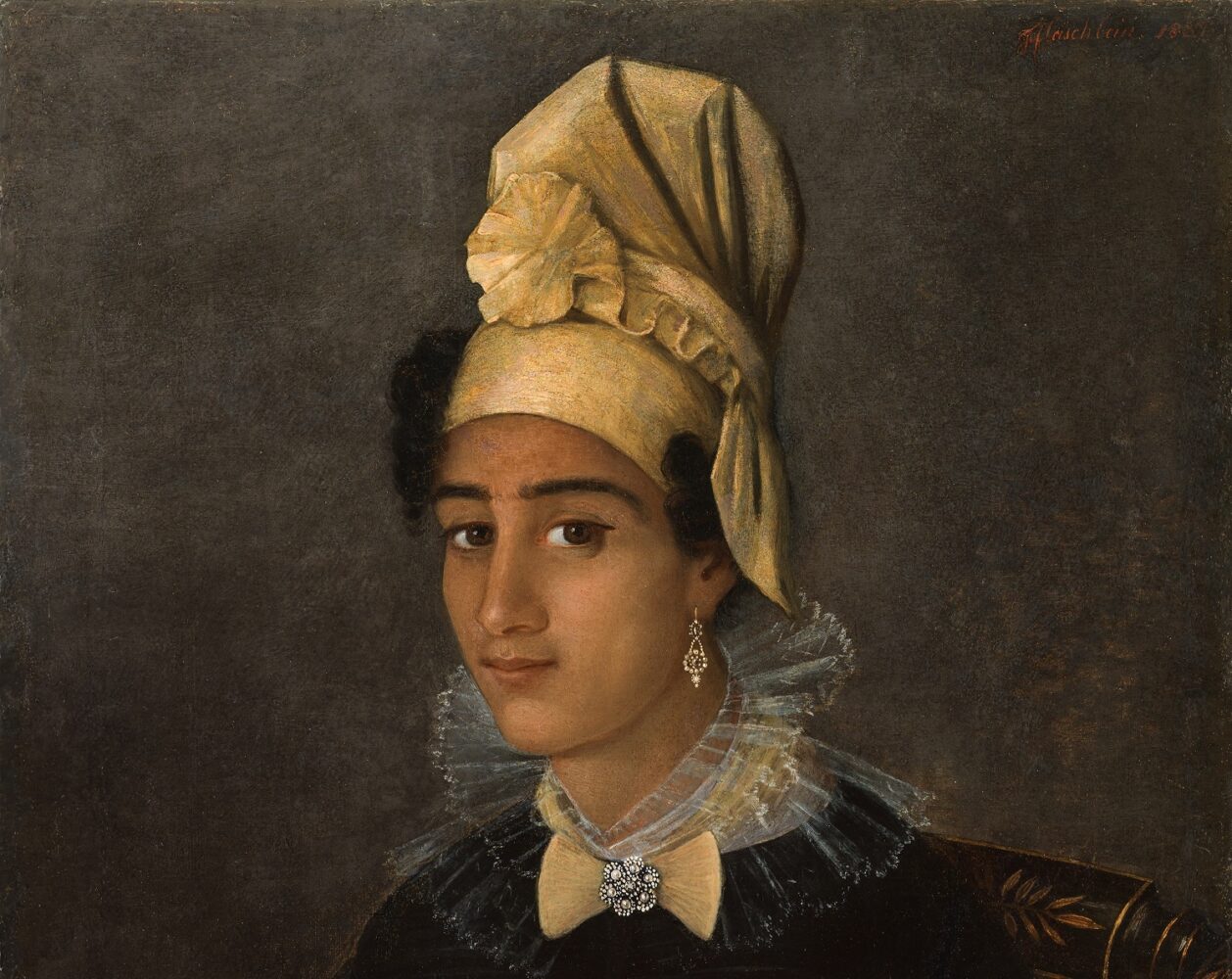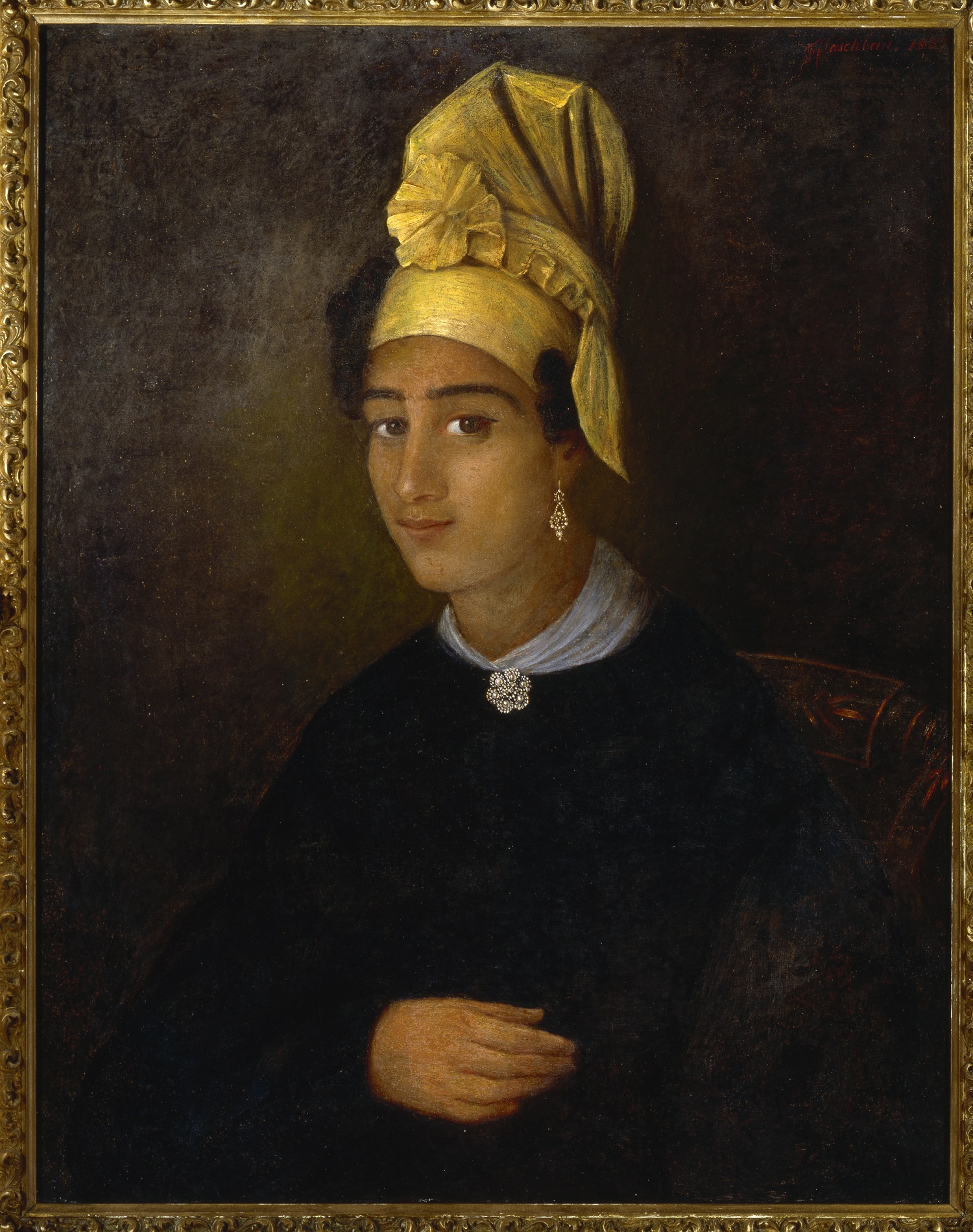Object Care
A tale of erasure, restitution, and possible resolution
Published: August 29, 2022
Last Updated: November 29, 2022

The Historic New Orleans Collection
The painting after it was restored in 2017.
Currently on display, Portrait of a Free Woman of Color features an interracial woman wearing a black dress. She emits an air of regality in a delicate white lace ruff enhanced with a bow and an immaculately folded golden tignon, or headwrap. She looks out at us with a glint in her eye, a slight smile on her lips, and one hand placed delicately on her stomach. Bavarian-born François Fleischbein painted the portrait in New Orleans in 1837, and THNOC purchased it in 1985. In 1976, a local art critic had published an unsubstantiated theory about the painting in the Times-Picayune, claiming that the subject was “probably Fleischbein’s slave, Betsy.” No records associate a woman named Betsy with the family nor indicate that Fleischbein was ever a slaveowner. The painting clearly depicts an affluent Black woman, likely a free woman of color, and the artist painted at least three other known portraits of free Black people—one of which THNOC would purchase in 2015. Yet the museum chose to title the painting Betsy and referred to her as a servant or housekeeper employed by the artist. The painting was presented with this title and description until 2020, when THNOC retitled it Portrait of a Free Woman of Color.
Additionally, in 1986 the museum contracted with Phyllis Hudson, LTD, for restoration work. With a loose canvas and tears and abrasions on the surface, the painting needed the care of a professional. Hudson applied drastic alterations to the painting. She overcleaned and then overpainted the canvas, covering up markers of wealth: a ruffled detail on the sitter’s sleeve, the gold and black paint on the chair, and most egregiously, the regal white lace ruff and bow-tied yellow ribbon.
The museum received the painting back from Hudson in 1988. Hudson said that, in her restoration, she had removed “added” elements of the painting. In other words, Hudson claimed that the collar and other opulent details were not original to the portrait; they were things the portrait sitter never wore. She told museum staff that a Black woman of that time period would not have possessed such fineries. Thus, by obscuring these markers of the sitter’s status, Hudson ostensibly put the sitter in her place.

The painting after treatment by a conservator in 1986. The Historic New Orleans Collection.
A board memo indicates that members were distressed over the damage done to the painting, but they opted not to disclose this to the public and actively prevented people outside the museum from investigating. As late as 2016, a curator told me that to reapply the collar would constitute an addition to the portrait rather than a restoration, and would only serve to further compromise the integrity of the painting.
However, one museum employee believed otherwise and reached out to conservator Craig Crawford in 2016. The next year Crawford removed Hudson’s overpaint and found traces of everything Hudson had concealed. He discovered detail on the sitter’s sleeve and the original coloring on the chair and backdrop. He reestablished these elements in the painting and, in so doing, returned the sitter to her former glory. A powerful representation of Black self-possession during an era of slavery and increased persecution of free Black people, the painting serves as a complex and complicated relic of African American history.
By 2021, a new administration led THNOC. In response to broader societal changes as well as increased visibility and public scrutiny following the publication of my writings on this painting, THNOC formed an internal committee to address the portrait’s history and created an extended wall label summarizing the story of the painting’s vandalism. With before and after images of the portrait, the label admits that THNOC’s “display and interpretation of the work made [the museum] complicit in the erasure of the sitter’s identity and integrity.” They also note that they hope one day to identify the woman portrayed. It is a step in the right direction, the acknowledgment of a wrong done—though, of course, there are limits to a label.
As they sort through the skeletons in their closets, white-dominant cultural institutions must reckon with the implicit violence of their complacency with and perpetuation of racist narratives. The obfuscation of one’s cultural heritage is connected to the oppression of a people, to such extent that organizations like UNESCO have noted that the destruction of cultural property always precedes genocide. The degradation of Black art by museums is a precondition for the violence that stimulated our recent cultural “revelations.”
For these institutions to rectify past wrongs, actions must occur alongside acknowledgements of the role they’ve played in the marginalization and outright erasure of Black culture and history, which served to uphold white supremacy. bell hooks once said, “there is no decolonizing process that does not involve reclaiming our past.” A full reclamation of our community’s past includes more research into the story behind this painting; publicizing the trajectory of this portrait; and centering it within the institution’s history. Decolonization of the institution involves purposeful dedication to the preservation of Black culture and a healed relationship with Black residents. With this work culpable institutions can carve a path towards a new collective shift in consciousness, one better informed by the truth and complexities of Black American history.
Lucia Olubunmi R. Momoh is a curator, writer, and scholar currently working as the Constance E. Clayton Curatorial Fellow at the Philadelphia Museum of Art. Her research examines issues of anti-Black racism, the production of history, and the role of cultural institutions. Momoh views her curatorial practice as an extension of her social and environmental activism and her museum and academic work as decolonial interventions.
